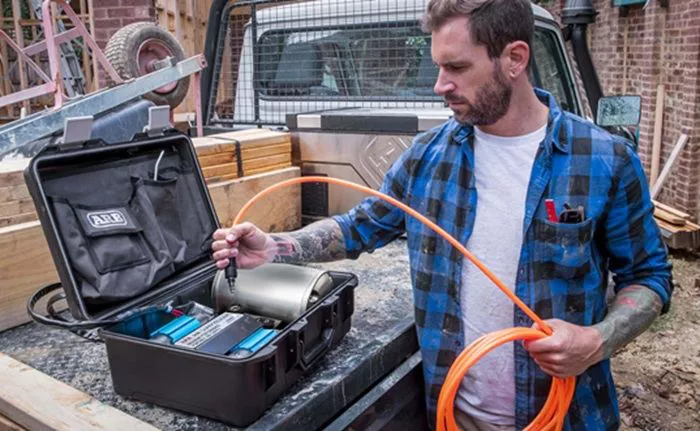When heading into the great outdoors, having a reliable portable air compressor can make a world of difference. Whether you’re inflating tires, powering tools, or handling various maintenance tasks, the right portable air compressor enhances your outdoor experience. This guide will help you navigate the key considerations for selecting the best portable air compressor for your adventures.
1. Understanding Your Outdoor Needs
Inflation Tasks: Determine what you’ll be using the air compressor for. Common uses in outdoor settings include inflating vehicle tires, recreational equipment (like kayaks and inflatable boats), and even powering small pneumatic tools. Knowing your primary needs helps you choose a model with the appropriate specifications.
Power Requirements: Assess the power requirements for your tasks. For instance, inflating tires might need a different level of power compared to operating a small air tool. Choose a model that can handle the demands of your specific applications.
2. Key Features to Look For
Portability and Weight: A portable air compressor should be easy to transport. Look for lightweight models with compact designs that can be easily carried or stored in your vehicle. Features like built-in handles or rolling wheels can enhance portability.
Power Source: Portable air compressors come with different power options, including AC power, DC power (via a vehicle’s cigarette lighter), or battery power. Consider the power sources available during your outdoor adventures and choose a compressor that suits those conditions.
Pressure and Airflow Capacity: Check the compressor’s pressure rating (measured in PSI) and airflow capacity (measured in CFM). Higher PSI and CFM ratings allow for faster and more efficient inflation. Ensure the model you select meets the pressure and airflow requirements for your tasks.
Durability and Build Quality: Outdoor environments can be harsh, so durability is crucial. Look for compressors with rugged construction and weather-resistant materials. Features like reinforced hoses and heavy-duty cases can enhance the compressor’s longevity.
3. Additional Features and Accessories
Digital Gauges and Controls: Models with digital gauges and controls offer greater precision and ease of use. They allow you to set desired pressures and monitor performance, reducing the risk of over-inflation and ensuring accurate results.
Built-In Lights: Some portable air compressors come with built-in LED lights, which can be helpful for use in low-light conditions or emergencies. This feature adds convenience and safety during nighttime or early morning tasks.
Auto Shut-Off Function: An auto shut-off feature automatically stops the compressor once the desired pressure is reached. This function helps prevent over-inflation and ensures the compressor doesn’t run unnecessarily.
Storage and Organization: Consider compressors that offer built-in storage compartments for accessories, such as nozzles, hoses, and power cords. This feature keeps everything organized and easily accessible.
4. Performance and Efficiency
Noise Levels: Portable air compressors can vary in noise levels. If you prefer a quieter operation, look for models designed to operate with reduced noise. This consideration is especially important if you’ll be using the compressor in shared or sensitive environments.
Efficiency and Speed: Evaluate the compressor’s efficiency and speed in completing tasks. A model with a high airflow rate and quick inflation capabilities can save time and enhance productivity.
Battery Life (for Battery-Powered Models): For battery-powered compressors, consider the battery life and charging time. Ensure the battery provides adequate runtime for your needs and that it charges quickly between uses.
5. Brands and Models to Consider
Popular Brands: Some well-regarded brands in the portable air compressor market include DEWALT, Makita, Black+Decker, and Viair. These brands are known for their reliability and performance in outdoor settings.
Top Models: Research and compare popular models within your budget. Consider reading reviews and testimonials to gauge user satisfaction and real-world performance.
6. Maintenance and Care
Routine Maintenance: Regular maintenance helps prolong the life of your portable air compressor. Follow the manufacturer’s maintenance guidelines, including checking and replacing air filters, lubricating moving parts, and inspecting hoses for wear and tear.
Cleaning and Storage: Keep the compressor clean and free of debris. Store it in a dry, protected area when not in use to prevent damage from environmental factors.
Troubleshooting Common Issues: Familiarize yourself with common issues that might arise and their solutions. Understanding basic troubleshooting can help you address minor problems and keep your compressor in good working condition.
Conclusion
Selecting the right portable air compressor for your outdoor adventures involves considering factors such as power requirements, portability, durability, and additional features. By understanding your specific needs and evaluating the key features of various models, you can find a compressor that enhances your outdoor experience and meets all your inflation and power needs.
Whether you’re heading out for a camping trip, off-roading adventure, or any other outdoor activity, a high-quality portable air compressor is an invaluable tool that ensures you’re prepared for anything. Choose wisely, and enjoy the convenience and reliability that the right compressor brings to your adventures.
Related Topics:
-
How Goal Zero Can Transform Your Outdoor Adventures With Reliable Energy?
-
Husqvarna Chainsaw: The Ultimate Tool For Professional And Home Use
-
Why Every Homeowner Needs An Oscillating Tool In Their Toolbox?

